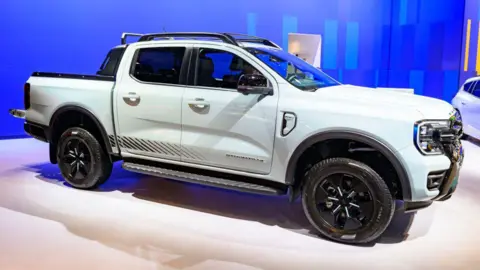
Why American Cars Struggle to Find a Market in Europe
Written by Jorn Madslien, Business Journalist
 Large American pickup trucks present challenges in navigating the narrow, historic streets of Europe
Large American pickup trucks present challenges in navigating the narrow, historic streets of Europe
Image credit: Getty Images
Former President Donald Trump has voiced his frustration over the relatively low sales of American vehicles in Europe, claiming it’s unfair that Europeans don’t purchase more US-made cars. The question remains: Why are American automobiles, excluding notable exceptions like Tesla, not widely embraced in the European market?
The answer is often tied to Europe’s ancient and labyrinthine towns, where navigating in large SUVs or trucks can be quite a challenge. As automotive industry expert Hampus Engellau remarks, "Driving a big SUV around Italy is a daunting task."
Fuel Costs Shape Preferences
Moreover, let’s consider the cost of operation. European drivers typically face higher fuel prices compared to their American counterparts. Mike Hawes, the CEO of the Society of Motor Manufacturers and Traders, emphasizes this point: "Given our higher fuel costs, consumers lean towards smaller, more fuel-efficient vehicles, while large vehicles are more popular in the US."
In contrast, Engellau notes that fuel in the United States is much cheaper, with prices noted in gallons rather than liters, impacting consumer choices significantly.
European Cars Thrive in the US Market
Despite these challenges for American manufacturers, European automakers have seen substantial success in the US. In 2022 alone, nearly 700,000 cars manufactured in the EU were exported to the US, with a significant economic impact of around €36 billion. Meanwhile, only a fraction of that—about 116,000—of US-made vehicles made their way to Europe, valued at €5.2 billion.
This disparity between import and export figures has led Trump to criticize trade practices, asserting that they are unfair. It’s worth noting that while the EU imposes a 10% tariff on US car imports, the US currently charges a much lower 2.5% tariff on cars from the EU.
 Small cars, such as the Fiat 500, dominate the European market
Small cars, such as the Fiat 500, dominate the European market
Image credit: Getty Images
Tariffs and Industry Dynamics
In response to the perceived imbalance, Trump has proposed raising tariffs on European automotive imports. His administration has already implemented a 25% tariff on essential materials such as steel and aluminum—key components for vehicle manufacturing. These moves have prompted European officials to consider adjusting their own tariffs to shield their automotive industry from potential fallout.
Jim Farley, CEO of Ford, has expressed concern over the chaos and added costs stemming from Trump’s tariff policies. In a broader perspective, industry veterans like Andy Palmer, who previously served at Nissan and Aston Martin, argue that concentrating solely on trade might be misguided. "Shipping cars globally doesn’t make sense; they are essentially large packages filled with expensive air," he notes.
Local Production Strategies
The automotive sector has evolved into a global entity where manufacturers aim to produce vehicles as close to their customers as possible. This includes several renowned European brands, like BMW and Mercedes, which are now producing significant models in North America—all while sending some of these cars back to Europe.
In a similar vein, US manufacturers such as General Motors have historically sought a strong presence in Europe but have pulled back in recent years. Ford has also restructured its European operations, prioritizing electric and commercial vehicles and stepping back from producing smaller, budget-friendly models.
Tough Competition and Market Nuance
The landscape in Europe remains competitive with a rising influx of brands from Asia and a strong preference for local makes. According to Jose Asumendi, who leads European automotive research at JP Morgan, there’s a strong inclination for consumers to support domestic brands, especially in countries like Germany and Italy, where local champions such as BMW and Fiat thrive.
Overall, while there’s an appreciation for American brands in Europe, the market dynamics and consumer preferences favor smaller, efficient vehicles—further complicating efforts for US automakers to gain a foothold in this intricate marketplace.
Conclusion
As Trump pushes for a stronger US automotive sector, experts like Palmer argue that fostering innovation through collaboration and investment will yield more significant benefits than a potential trade war. Ultimately, to thrive in the European market, understanding local demands and preferences will be key, as the region remains fiercely competitive with a plethora of choices for consumers.
Stay tuned for more insights on global business trends.









